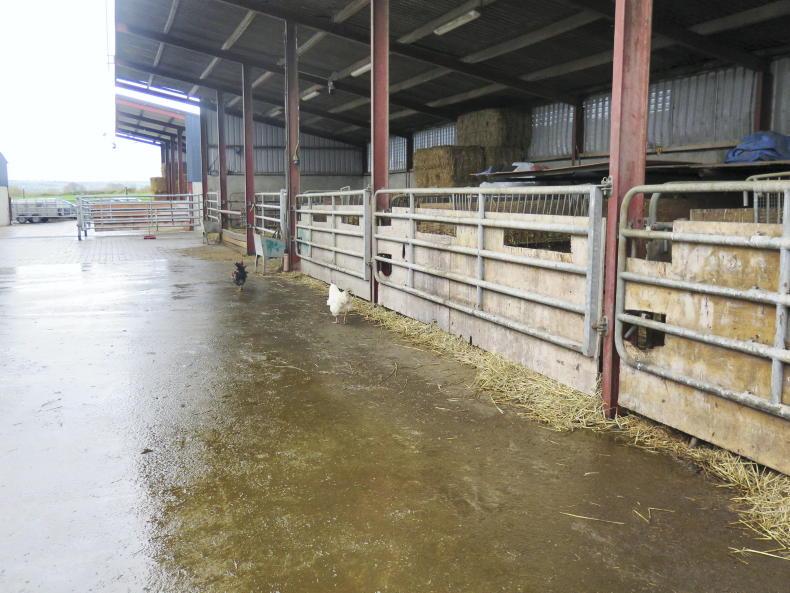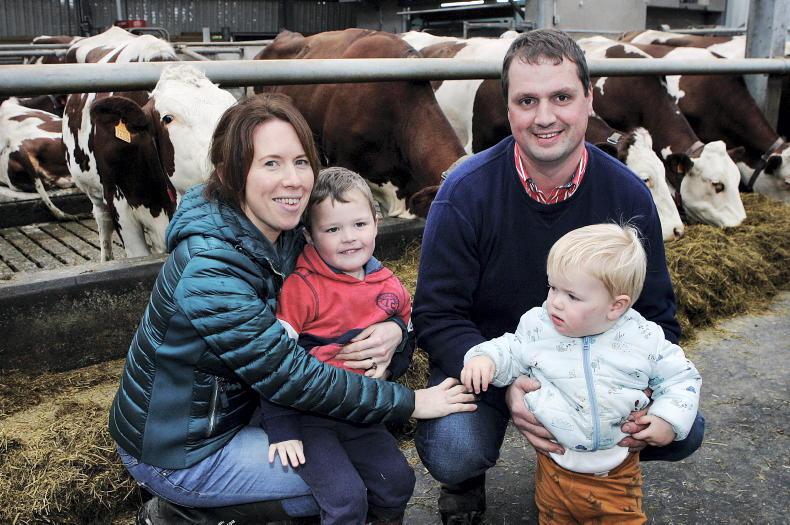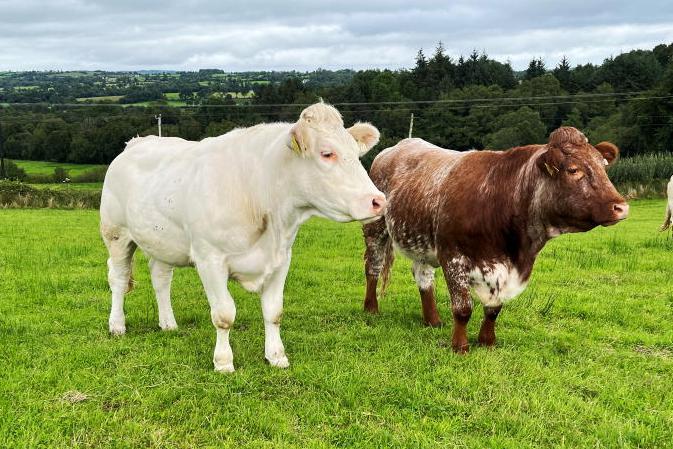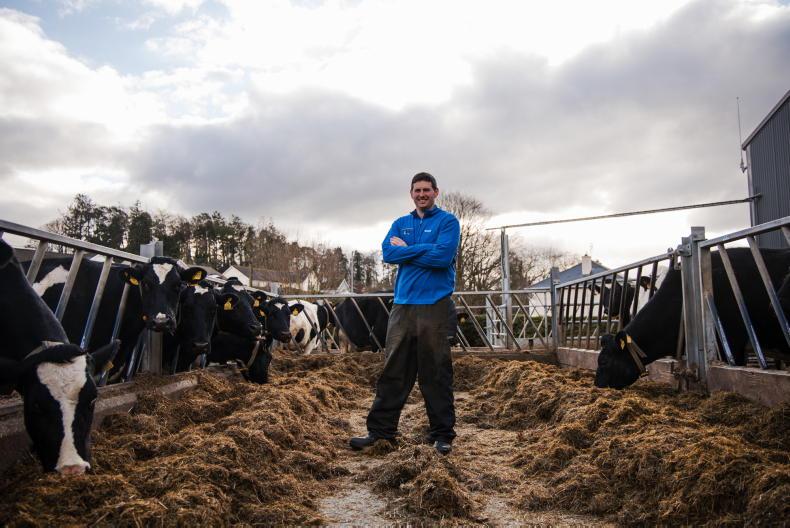The importance of fertility and managing calving interval was one of the key messages from the Teagasc/Aurivo joint programme farm walk on the Porter family farm at Castlefinn, Co Donegal, last Tuesday.
Gareth and Dawn Porter are running a herd of 210 Holstein Friesian cows in a split-calving system, with 40% calving in autumn and the remainder calving in spring. Milk solids production is high at 547kg MS/cow at 3.96% fat and 3.38% protein from an average of 2.5t of meal per cow.
Over 200 farmers from the region attended the walk and were told that the long-term target is to increase milk solids per cow to 600kg, while reducing the amount of meal fed to 2t per cow.
Grass growth rates are already high at 15t DM/ha, so the only real way of improving efficiency was to focus on improving fertility to improve milk yield.
At present, the calving interval in the herd is 459 days while the average among winter milk suppliers to Aurivo is 414 days and the top 10% of Aurivo winter milk suppliers are achieving 379 days calving interval.

Calf sheds on the Porter farm
While the target for calving interval is 365 days, even getting down to 390 days would add about 50kg of milk solids to each cow in the Porter herd straight away.
Teagasc adviser Cian Devanny says the issue with a long calving interval is that too many cows in the herd are stale at any time and not enough cows are milking at peak.
“It all boils down to fertility. We need more cows at peak production and we need them to hit that peak more regularly and the only way they’ll do that is by calving more often. Increasing milk production starts with breeding for fertility, in my view genetics for milk comes after fertility,” Cian says.
He advised farmers to breed cows that are balanced in terms of milk and fertility along with size and functional traits. He says the ideal cow type for a winter milk system is usually the same cow that’s ideal for a spring-calving system.
“When looking at the EBI milk sub-index, you need to look beyond the figure itself and see where it’s coming from.
“A lot of farmers get very worked up about kilos of volume but it tells you very little really.
“The predicted transmitting abilities (PTA) for combined kilos of fat and protein are more important and so too is the percentages of fat and protein.
“I know some winter milk farmers will say that they’re producing liquid milk for six months of the year, but outside of that time they’re being paid on an A plus B minus C system. Increasing fat and protein percent is the only way farmers have of adding value to their milk,” he says.
The target on the Porter farm is to reduce calving interval to 390 days by tightening up the breeding season for both groups and by avoiding carrying over cows from spring to autumn and vice versa.
All high-EBI Holstein Friesian bulls have been used in the past year. Cian also says that some of the lower-performing cows will also be bred to beef, which will increase the genetic merit of the replacements.

The milking herd are on a TMR containing high quality silage and a home mixed ration
At this stage, 96% of the autumn-calving cows on the Porter farm are calved and a share of the early-calving spring herd is now dried off. The herd average yield is 25l per day at 4.26% fat and 3.49% protein, which is 1.99kg MS/cow on 9.5kg of meal.
Feeding
The silage on the Porter farm is excellent quality with an average DMD of 84% and a crude protein content of 16%. This silage was cut in early May.
Teagasc winter milk specialist James Dunne says making quality silage is essential, particularly in winter milk herds, as it means more milk can be produced from forage and less meal is required.
On the Porter farm, the milking cows are in two groups and are fed a total mixed ration depending on their milk yield with the heifers and later-lactation cows in one group and all the high-yielding cows in another group.
The high group is fed 11.5kg DM of silage, 6.5kg of 20% protein home-mixed blend including wheat, maize, soya hulls and soya bean meal. They are also fed according to yield in the parlour, with any cow milking over 28kg of milk daily being fed an extra 0.35kg of meal for every 1kg of milk produced.
With the cost of silage likely to be much higher next winter due to rising fertiliser costs, James says that for farmers who have a cash surplus this year, it may be worth buying silage now if it means they can carry extra silage stocks into next winter as the relative cost of silage is attractive at present relative to other feeds.
On other feeds such as beet or brewers grains, he says that while they may be attractive in terms of cost and quality, the workload involved in feeding these other feeds, plus the investment in machinery or infrastructure to feed them out, should be borne in mind.
He also says that farmers should resist the temptation to make very bulky silage next season.
“With the high cost of fertiliser next year, some farmers will be tempted to let silage crops run on and get a good bulk out of them.
“While the tonnage harvested will increase, what we tend to see happening in these situations is that the first cut is a good bit later than normal and as a result the second and subsequent cuts are much lighter.

Attending the Montbeliarde Open Day, Newtownstewart are Dawn and Gareth Porter from Castlefinn with their sons Alec (4) and Archie (1).

Attending the Montbeliarde Open Day, Newtownstewart are Dawn and Gareth Porter from Castlefinn with their sons Alec (4) and Archie (1).
“At the end of the season there is no extra silage in the yard, but the quality of that silage is a lot less compared to earlier cutting,” James says.
Labour
Teagasc specialist Martina Gormley outlined the results of a new labour study carried out on dairy farms. Of the 600 farms analysed, 120 were liquid milk with an average herd size of 104 cows.
The study found that farmer hours worked per week are higher on liquid milk herds with an average of 66 hours worked per week compared to 61 hours on spring-calving farms. Within the liquid milk herds, the top 10% of farmers on hours worked did an average of 57 hours per week.
Martina identified milking interval as being one of the main drivers of the extra workload on liquid milk farms. She said the top 10% of farmers finish their working day one hour earlier than the average and they start the evening milking one hour earlier and use a shorter milking interval of nine hours.
Other practices on the time-efficient farms include once-a-day feeding of calves, less assistance given at calving, more use of contractors, more compact calving season (which relies on extra labour during that period and good facilities, but less overall hours worked) and much less topping being done.
She said that on many farms topping is just being done out of habit, but which takes up a lot of time.
On the subject of milking interval, she said there is no correlation between milking interval and milk yield per cow. This means that cows on a seven-hour milking interval are as likely to have the same daily yield as those on a 12-hour milking interval.
However, there is a very strong correlation (60%) between milking interval and the length of the working day. So farms that employ a long milking interval are much more likely to have a long working day and vice versa. Data for this analysis was got from milk recording data from over 2,300 farms.
“Farmers are not only competing with each other for people to work on farms but also with factories and employers in other sectors.
“One of the reasons we often hear back from people who go to work in other sectors is that they know how many hours they’ll be working, they know their finish time and they get to work in a clean environment. That’s what farmers are competing against,” she says.
Key points
Winter milk farm
walk on Gareth and Dawn Porter’s farm, Castlefinn, Co Donegal. Milking 210 cows on a 150ha farm.60% spring-calving and 40% autumn-calving supplying Aurivo Co-op.Calving interval currently 459 days and target is 390 days.
The importance of fertility and managing calving interval was one of the key messages from the Teagasc/Aurivo joint programme farm walk on the Porter family farm at Castlefinn, Co Donegal, last Tuesday.
Gareth and Dawn Porter are running a herd of 210 Holstein Friesian cows in a split-calving system, with 40% calving in autumn and the remainder calving in spring. Milk solids production is high at 547kg MS/cow at 3.96% fat and 3.38% protein from an average of 2.5t of meal per cow.
Over 200 farmers from the region attended the walk and were told that the long-term target is to increase milk solids per cow to 600kg, while reducing the amount of meal fed to 2t per cow.
Grass growth rates are already high at 15t DM/ha, so the only real way of improving efficiency was to focus on improving fertility to improve milk yield.
At present, the calving interval in the herd is 459 days while the average among winter milk suppliers to Aurivo is 414 days and the top 10% of Aurivo winter milk suppliers are achieving 379 days calving interval.

Calf sheds on the Porter farm
While the target for calving interval is 365 days, even getting down to 390 days would add about 50kg of milk solids to each cow in the Porter herd straight away.
Teagasc adviser Cian Devanny says the issue with a long calving interval is that too many cows in the herd are stale at any time and not enough cows are milking at peak.
“It all boils down to fertility. We need more cows at peak production and we need them to hit that peak more regularly and the only way they’ll do that is by calving more often. Increasing milk production starts with breeding for fertility, in my view genetics for milk comes after fertility,” Cian says.
He advised farmers to breed cows that are balanced in terms of milk and fertility along with size and functional traits. He says the ideal cow type for a winter milk system is usually the same cow that’s ideal for a spring-calving system.
“When looking at the EBI milk sub-index, you need to look beyond the figure itself and see where it’s coming from.
“A lot of farmers get very worked up about kilos of volume but it tells you very little really.
“The predicted transmitting abilities (PTA) for combined kilos of fat and protein are more important and so too is the percentages of fat and protein.
“I know some winter milk farmers will say that they’re producing liquid milk for six months of the year, but outside of that time they’re being paid on an A plus B minus C system. Increasing fat and protein percent is the only way farmers have of adding value to their milk,” he says.
The target on the Porter farm is to reduce calving interval to 390 days by tightening up the breeding season for both groups and by avoiding carrying over cows from spring to autumn and vice versa.
All high-EBI Holstein Friesian bulls have been used in the past year. Cian also says that some of the lower-performing cows will also be bred to beef, which will increase the genetic merit of the replacements.

The milking herd are on a TMR containing high quality silage and a home mixed ration
At this stage, 96% of the autumn-calving cows on the Porter farm are calved and a share of the early-calving spring herd is now dried off. The herd average yield is 25l per day at 4.26% fat and 3.49% protein, which is 1.99kg MS/cow on 9.5kg of meal.
Feeding
The silage on the Porter farm is excellent quality with an average DMD of 84% and a crude protein content of 16%. This silage was cut in early May.
Teagasc winter milk specialist James Dunne says making quality silage is essential, particularly in winter milk herds, as it means more milk can be produced from forage and less meal is required.
On the Porter farm, the milking cows are in two groups and are fed a total mixed ration depending on their milk yield with the heifers and later-lactation cows in one group and all the high-yielding cows in another group.
The high group is fed 11.5kg DM of silage, 6.5kg of 20% protein home-mixed blend including wheat, maize, soya hulls and soya bean meal. They are also fed according to yield in the parlour, with any cow milking over 28kg of milk daily being fed an extra 0.35kg of meal for every 1kg of milk produced.
With the cost of silage likely to be much higher next winter due to rising fertiliser costs, James says that for farmers who have a cash surplus this year, it may be worth buying silage now if it means they can carry extra silage stocks into next winter as the relative cost of silage is attractive at present relative to other feeds.
On other feeds such as beet or brewers grains, he says that while they may be attractive in terms of cost and quality, the workload involved in feeding these other feeds, plus the investment in machinery or infrastructure to feed them out, should be borne in mind.
He also says that farmers should resist the temptation to make very bulky silage next season.
“With the high cost of fertiliser next year, some farmers will be tempted to let silage crops run on and get a good bulk out of them.
“While the tonnage harvested will increase, what we tend to see happening in these situations is that the first cut is a good bit later than normal and as a result the second and subsequent cuts are much lighter.

Attending the Montbeliarde Open Day, Newtownstewart are Dawn and Gareth Porter from Castlefinn with their sons Alec (4) and Archie (1).

Attending the Montbeliarde Open Day, Newtownstewart are Dawn and Gareth Porter from Castlefinn with their sons Alec (4) and Archie (1).
“At the end of the season there is no extra silage in the yard, but the quality of that silage is a lot less compared to earlier cutting,” James says.
Labour
Teagasc specialist Martina Gormley outlined the results of a new labour study carried out on dairy farms. Of the 600 farms analysed, 120 were liquid milk with an average herd size of 104 cows.
The study found that farmer hours worked per week are higher on liquid milk herds with an average of 66 hours worked per week compared to 61 hours on spring-calving farms. Within the liquid milk herds, the top 10% of farmers on hours worked did an average of 57 hours per week.
Martina identified milking interval as being one of the main drivers of the extra workload on liquid milk farms. She said the top 10% of farmers finish their working day one hour earlier than the average and they start the evening milking one hour earlier and use a shorter milking interval of nine hours.
Other practices on the time-efficient farms include once-a-day feeding of calves, less assistance given at calving, more use of contractors, more compact calving season (which relies on extra labour during that period and good facilities, but less overall hours worked) and much less topping being done.
She said that on many farms topping is just being done out of habit, but which takes up a lot of time.
On the subject of milking interval, she said there is no correlation between milking interval and milk yield per cow. This means that cows on a seven-hour milking interval are as likely to have the same daily yield as those on a 12-hour milking interval.
However, there is a very strong correlation (60%) between milking interval and the length of the working day. So farms that employ a long milking interval are much more likely to have a long working day and vice versa. Data for this analysis was got from milk recording data from over 2,300 farms.
“Farmers are not only competing with each other for people to work on farms but also with factories and employers in other sectors.
“One of the reasons we often hear back from people who go to work in other sectors is that they know how many hours they’ll be working, they know their finish time and they get to work in a clean environment. That’s what farmers are competing against,” she says.
Key points
Winter milk farm
walk on Gareth and Dawn Porter’s farm, Castlefinn, Co Donegal. Milking 210 cows on a 150ha farm.60% spring-calving and 40% autumn-calving supplying Aurivo Co-op.Calving interval currently 459 days and target is 390 days. 













SHARING OPTIONS